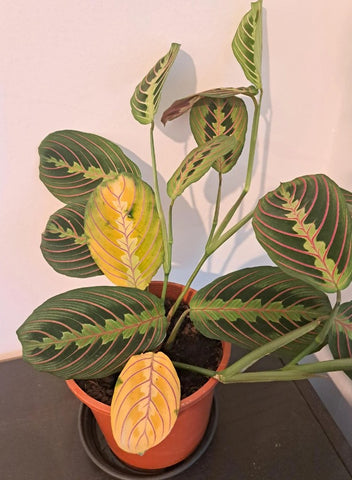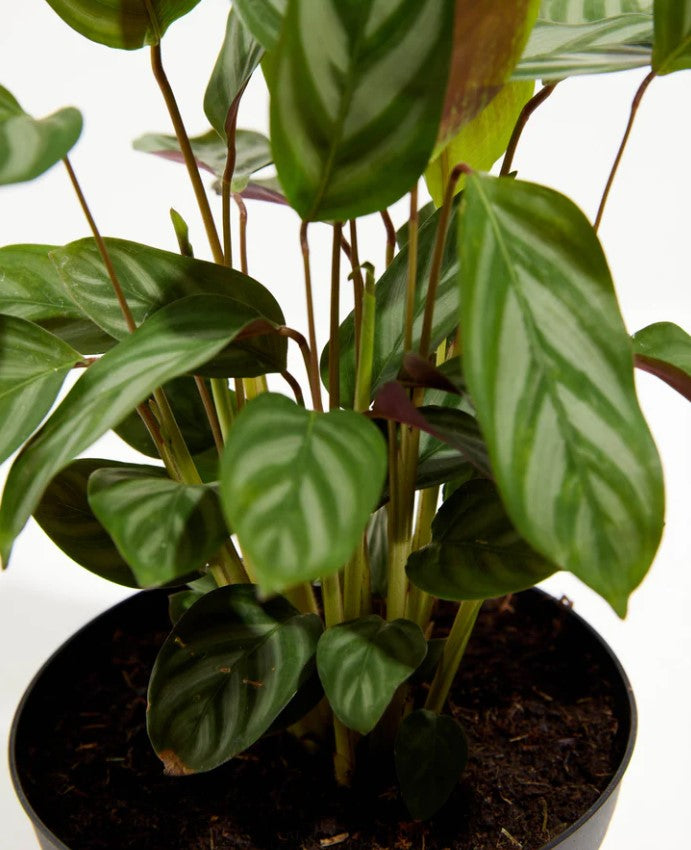Alright, let’s talk about my journey with the prayer plant, the Maranta. It wasn’t always smooth sailing, let me tell ya.
Getting Started and Finding Its Spot
I picked up my first prayer plant because I just loved how the leaves looked, those intricate patterns are something else. Brought it home, super excited. First thing I did was try to figure out where it wanted to live. I initially put it near a south-facing window, thinking plants love sun. Big mistake. Within a few days, I noticed the leaves looked a bit faded, almost scorched.

So, I started moving it around. Tried a spot further back from the window. Better, but still not quite right. Eventually, I landed on a shelf in my living room. It gets bright, indirect light there – no direct sunbeams hitting it at all. That seemed to be the sweet spot. It’s near an east-facing window, but shielded by a bigger plant.
The Watering Game
Watering was the next puzzle. I read they like moist soil, but not soggy. What does that even mean in practice? Well, I learned the hard way. First, I think I underwatered it. The leaves started getting crispy edges and curling up more than usual. Okay, noted.
Then I probably overcompensated. Watered it too much, kept the soil wet all the time. The lower leaves started turning yellow. Yikes. Finding that balance took time. Now, what I do is stick my finger about an inch into the soil. If it feels dry at that depth, I give it a good drink. I use filtered water, or tap water that I’ve let sit out overnight. Seems to make a difference, maybe less harsh chemicals? I water until it drains out the bottom, then I make sure to dump the excess water from the saucer. Don’t want it sitting in a puddle.
Humidity Helper
I quickly realized my house is pretty dry, especially in winter. Prayer plants are tropical, they crave humidity. Those crispy leaf edges I mentioned? Low humidity was definitely part of the problem. Misting helped a little, I did that daily for a while. But honestly, the biggest change came when I set up a pebble tray.
It’s simple: just a shallow tray filled with pebbles and water. I set the plant pot on top of the pebbles, making sure the bottom of the pot isn’t actually submerged in the water. The evaporating water creates a nice humid microclimate around the plant. Sometimes I also group it with other plants; they kind of help each other out with humidity.
Soil and Repotting
When I first got it, it was in some generic nursery soil. After about a year, it seemed a bit sluggish, and I noticed roots peeking out the bottom. Time to repot. I went up one pot size, nothing too drastic. For the soil mix, I didn’t get too fancy. I just used a standard houseplant potting mix but added some extra perlite to it. This helps with drainage, preventing that soggy situation I learned to avoid.
I just gently loosened the old soil from the roots, popped it in the new pot with the fresh mix, filled around it, and gave it a light watering. I usually repot in the spring when it’s starting to grow more actively.

Feeding Time
I don’t go crazy with fertilizer. During the growing season, spring and summer mostly, I feed it maybe once a month. I use a balanced liquid houseplant fertilizer, but I dilute it to half the strength recommended on the bottle. Learned that lesson too – too much fertilizer can burn the leaves. Less is more with these guys, I found. In fall and winter, I basically stop feeding altogether because the plant’s growth slows right down.
Dealing with Drama (Brown Tips & Yellow Leaves)
Despite my best efforts, I still get the occasional brown tip. Usually, it’s a sign I slipped up on watering or the humidity dropped. I just snip the brown part off cleanly if it bothers me. Yellow leaves usually mean I overwatered, so I check the soil and let it dry out more before watering again. It’s all about observing and adjusting.
Oh, and the coolest part? Watching the leaves fold up at night, like hands in prayer. That’s how you know it’s generally happy. If it stops doing that, something’s usually up with its environment.
Overall Thoughts
So yeah, caring for a prayer plant has been a learning process. It’s a bit fussier than some other houseplants, definitely needs consistent attention to its light, water, and humidity needs. But once you figure out what your specific plant likes in your specific home environment, it’s really rewarding. Seeing those leaves move and unfurl new growth makes the effort totally worth it for me.





















